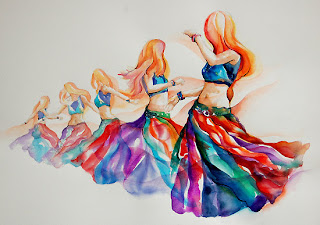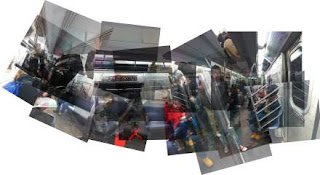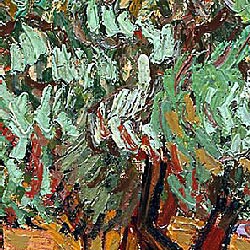Wednesday, May 11, 2011
Illusion of Motion by Multiple Image
I chose the image above not only because I feel that it represents the topic, but I also chose it because it was similar to an assignment we did in class. This painting is successful because it gives you the impression that this figure that is in place is going to make a move. You anticipate that some sort of movement might occur.
Alternating Rhythm
The piece relates to alternating rhythm because of its consistent pattern. You are able to anticipate what will happen next in the piece. What makes this piece perfect to describe alternating rhythm is that it has a predictable quality to it.
Tuesday, May 10, 2011
Illusion of Motion by Blurred Outline
When I think of blurred motion, I typically think of photographs my grandma is taking and someone within it moves. The photo above I feel is a good example because the figure appears to not be in motion, but it is really the people behind who are not moving as fast.
Illusion of Motion by Repeated Figure
For this blog, I thought I would do something different. Although there appears to be the same figure but in different color. The picture is actually composed of various people to represent a Tetris map. This picture, taken from a youtube video repeats the constant parade of people representing Tetris blocks in different colored t-shirts. It is a really neat video to checkout by the way.
Anticipated Motion
The photo above appears to be a woman dancing. The figures that appear more transparent are meant to show the future or previous movement that she has possessed. I felt as if this was a good example because you are able to anticipate what might happen to in her movements.
Spatial Puzzles
Equivocal Space is the concept of using transparency to confuse the perception of depth. I used the photo above because I feel that it uses transparency to create depth. The various lines and shapes pass through each other and overlap to create a sense of three dimensionality.
Multiple Perspective
Multiple perspective is the use of taking different stock photos and placing them in a fashion that would make up the image but in different viewpoints.An example of this is the photo above. Various photos from one place are taken and composed to make one. Although the various pictures are of different focus and timeframe, they make up one larger photo that conceptualizes the various time, space, and motion that make up life.
Amplified Perspective
Amplified perspective is the idea of taking a visual image and reproducing it so that it looks directly at the viewer. In this case, you get the idea of a camera directly pointed at two different feet. It is similar to a first person perspective, or at least in this case. you look at the feet as if you are one of the owners.
Illusion of Space by Linear Perspective
The picture above is an example of a two point perspective. What you have to understand with linear perspective is that it gives you the impression that you are looking straight at a corner and that you can see the vanishing point. In this case, there are two vanishing points one on the right, and the other on the left. With one perspective you get the idea that you are are looking at a vanishing point. Everything from that point stems out from a certain angle. The drawing below is an example.
Illusion of Space by Aerial Perspective
The picture above is successful in illustrating an aerial perspective by using overlapping layers. The various hills that sprout up give off a three-dimensional feel that helps you understand the depth of the background.
Illusion of Space by Vertical Location
The picture above uses vertical location in its arrangement. In this piece called the vertical gardens, the artist intended to create a "living sculpture." His plan was not only to create something that is aesthetically pleasing but would also help the habitat. To do so, the artist planted seeds through out the sculpture to help preserve wild life. Sometimes vertical arrangements are the most convenient. This piece is easy to accommodate the city lifestyle setting.
Illusion of Space by Overlapping
Using space to create a three dimensional feel is very common in lots of art and movie posters. This particular poster from the movie, The Social Network, uses typography and the top portion of the Facebook page to overlap the leading actor. Without the overlapping objects, this poster would be nothing more than a photograph. However, you are viewing an illusion that makes you feel as if the type is scrolling in front of the actor.
Saturday, May 7, 2011
Scale confusion
Scale confusion makes you stop and think about where the placement of objects should be. We are all accustomed to everything being where it should be. Confusing someone makes them uncomfortable.
Absence of focal point.
There is not much to say about this other than the fact that having no focal point means that your eye can not be drawn to something initially.
emphasis on placement
Like the isolation, placing an object in a particular way dictates how it is perceived. The baseball below is seen as the focal point because it is focused and zoomed in on.
Emphasis on isolation
Isolating an object in a work of art also creates a focal point. The example below takes a circle and removes it from a large group of circles. The isolation points out the difference.
Crystallographic balance
Crystallographic pattern is a very popular of our culture, think pajama pants or the Vera Bradley purses and bags you might see on campus.
Radial Balance
Radial balance involves an object with consistent extensions. Examples of these are flowers and drawings of the sun.
Symmetrical Balance
For something to be symmetrical there must be continuity on both sides to compensate for each other. This bedroom has a bedside table and lamp that mirror each other.
Continuity
With continuity I feel as if it is different because it must hold up a trend opposed to something that trails, having an ending and beginning.
Continuation
The image above is considered unity through continuation because the showcases and people progressing appear to leave a belief that there is more to see.
Unity through repetition
These apples do have their own unique qualities. However, when they are lined up and have sticks punctured in them they become repetitive and and unified.
Unity through proximity
Observe a group of people in a room. You can often learn a lot about who is listening intently to another person, which are strangers, or who is ignoring who by how close together they sit or stand. In design, proximity or closeness creates a bond between people and between elements on a page. How close together or far apart elements are placed suggests a relationship (or lack of) between otherwise disparate parts. Unity is also achieved by using a third element to connect distant parts.
Curvilinear art is characterized by a curving line used to form abstract patterns, such as spirals, circles, swirls, and S-shapes, as well as to define human facial features. The straight line and the right angle are practically nonexistent in both the abstract and the anthropomorphic types of ornamentation.
Friday, May 6, 2011
Rectilinear Shapes
Rectilinear art involves polygons that meet at right angles. This piece fits this description because all of the objects connected from the base to the top interject each other at ninety degrees. Making it easier to make it more balanced.
Abstraction
I know there are abstract painters who say you can hang their art any way you want to--that it works in any direction. But I don't paint that way. Once I get to a certain stage in the process, I keep the same orientation and expect the painting to be hung that way.
On the other hand, occasionally a client wants a print of a square painting in a vertical or horizontal format, and sometimes it works well. Success or failure depends on the design and composition
Idealism
Idealism places special value on ideas and ideals as products of the mind, in comparison with the world as perceived through the senses. In art idealism is the tendency to represent things as aesthetic sensibility would have them rather than as they are.
Distortion
Distortion in art does not depart from a recognisable norm: distortion can be used intentionally or unintentionally. It was used intentionally for expressive and emotional ends in the 20th century. Not only figures, but objects and space can be distorted.
Naturalism
The painting above is an attempt to realistically paint the depiction of Icarus drowning. However, it looks more so like a depiction of a painting involving a ship yard and a farmer tilling his garden.
Lost and found contour
The drawing above emphasizes color and value more so than line. The various shades that create the image you see before you is created in a ms paint fashion. If someone were to have a spray can and sprayed it in varying intensities, you would have a similar result.
Thursday, May 5, 2011
Line as value
Value pertains to the use of light and dark, shade and highlight, in an artwork. Black and white photography depends entirely on value to define its subjects. Value is directly related to contrast. Value is the darkness and lightness of an object depending on how the light is shown.
The picture below uses value in the form of cross-hatching.
The picture below uses value in the form of cross-hatching.
Gesture Lines
A gesture drawing is work of art defined by rapid execution. Typical situations involve an artist drawing a series of poses taken by a model in a short amount of time, often a little as 30 seconds, or as long as 2 minutes. Gesture drawing is often performed as a warm-up for a life drawing session.
Contour line
A contour line is an outline. It represents the exterior edges of an object and is a clean, connected line with no shading. Learning to see the outline of something and being able to draw the lines exactly as they are is one of the first steps to becoming a skilled artist. Many beginning artists draw a representation of what they see instead of what they actually see.
Line as emotion
Line can be used to convey a variety of emotions. For example, a zig zag can represent angry emotions. A wavier line can also represent an emotion that is safe opposed to a jagged line. Even a straight line can represent a quiet line.
In the picture above it appears that whatever these lines represent is dangerous because of its qualities.
In the picture above it appears that whatever these lines represent is dangerous because of its qualities.
Line direction
The diagonal line has no equal in visual intensity. It suggests depth or movement. The periphery of the eye is very sensitive to movement or to any diagonal, so it calls for complete attention from the viewer. That is why traffic signs designed to warn of hazards are diamond shaped, using diagonals.
Vertical and horizontal lines infer a static or decorative visual condition. An example is a top hat. It appears taller than it is broad, but this is an illusion.
In architecture, the Parthenon in Athens is said not to have a straight line in it. In fact, curved lines are used in many cases to make the straight lines appear straighter. For example, there are three terraces at the bottom of the Parthenon. If they were not curved, they would appear to sag, as they are three inches higher in the middle than at the ends. The builders of the Parthenon placed all the horizontal lines at the bottom, the vertical lines in the middle and the diagonal lines at the top. This creates a decorative design by making the lines appear all on one plane. |
Line as shape
This photo below shows that line is what makes up shape. It also shows the two possible shapes that line can make up, An open shape and and a close shape.
Subscribe to:
Posts (Atom)














































